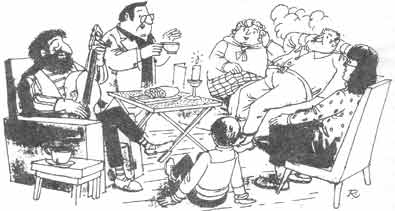In the Wake of the Barbarians
"The barbarians have taken over—the despisers of culture!"
It is probable that very few Catholics, even traditionalists, realize fully the extent of the havoc wrought by the so-called liturgical "renewal," which has really been a revolution. To all intents and purposes an entire culture has been destroyed. Let those who doubt it enter churches, seminaries, and convents which they knew before the Council, and compare what was there then with what remains. The late Archbishop Robert J. Dwyer, of Portland, Oregon, laments in the article which follows that "the barbarians have taken over, the despisers of culture" and that we have "lost at least an entire generation in the process." If your friends tell you that traditionalists exaggerate in their complaints about the changes then lend them this article; it is brief, but it says all that needs to be said. John Ryan's illustrations make the same point with even more force. The barbarians have indeed passed through the sanctuaries of our country. We, of the Society of St. Pius X, are attempting to rebuild a few bastions of authentic Catholicism for the remnant of the true faithful who remain. If this makes us rebels then we are proud to bear the title! Rebellion against barbarism is not such a bad thing! If your pastor has employed sledge hammers to destroy the beauty of your parish church it is even possible that this issue of our magazine might give him some qualms of conscience. Why not order an extra copy for him? Grateful acknowledgments to Christian Order for Archbishop Dwyer's article (May 1976).
IT HAD BEEN a good many years since we had visited the chapel where the glorious triptych, looming above the altar, seemed to glow, as we remembered it, with its own inner light. The last time we were there (it must have been in the early or middle '60s) the convent was well-peopled, and the white-robed novices appeared to our mundane gaze veritably to float in and out of the choir stalls on their mysterious and intriguing missions.
The triptych, with its center panel of Our Lady and her Little Son, and the four side panels, scenes from the Virgin's life, the traditional themes in a strong yet sensitive modern interpretation, was the work of one of the greatest American artists, the late Charlton Fortune, a woman as gifted intellectually as artistically, whose occasionally caustic wit gave point to her bracing critical sanity.
Then the altar and triptych were the heart and center of this house of prayer. The bronze tabernacle, elegantly chased, was covered with a deftly tailored veil of rich and sober materials, as was called for in those days when the sacred rubrics were taken seriously.
The carved candlesticks, silvered and polychromed, were topped by tall, immaculate candles, and the frontal, a masterpiece of needlecraft, reflected the tones and spirit of the whole composition. To stand before it, or to kneel in prayer, meant something of a pilgrimage fulfilled, an aesthetic blessing no less than a moment of spiritual exaltation.
Responsive
Now it need not be supposed that the Sisters, the novices and the postulants who were so eagerly pressing forward to their life of total dedication, were all equally responsive to the artistic treasure their convent held and around which their prayer and sacramental life evolved.
Some even then may have been indoctrinated in the New Puritanism which was infiltrating the Church, with its arrogant disdain for beauty and its insistence on a kind of naked functionalism, as conducing, so it was argued, to the untrammeled concentration on the unseen and intangible verities.
But for most, surely, the loveliness before them, day after day, the visual experience of great art, must have had its effect in a heightened appreciation of the ministry of art in the Church, and to something of that catharsis, that cleansing of the spirit, which Aristotle predicted of all significant aesthetic enjoyment.
Well, ours was not a happy return. The convent building stands and the chapel, but the novitiate is there no longer, since there are so few novices (if any) that a separate structure to house them would be a foolish luxury. Like most communities of women (and of men) in this country, this one had suffered from the deliberate distortion of Vatican II, the calculated misinterpretation of its spirit, and had undergone a profound transformation while losing heavily in personnel and recruitment.
Actually, in contrast to many of the sisterhoods, this community held at least to the basics of religious life; the nuns were still identifiable as nuns, and the rule, if modified, was nevertheless a fairly structured way of life.
Satisfaction
The convent, we learned, was being used as a retreat center, and the sister in charge told us with evident satisfaction of the groups, some Protestant, some Charismatic, that came here for some sort of spiritual exercises or liturgical celebrations. It was no longer the scrupulously clean house with the polished floors and a total innocence of dust or grime. It was a little frowsy.
The chapel? we asked. Oh yes, it's still there, and we could see it if we liked. Not that it's in much use nowadays, except to reserve the Blessed Sacrament. We prefer to have Mass in the anteroom where it's much more intimate and we can gather 'round the altar to celebrate.
Sure enough, as we passed through the vestibule, a fairly large room, there was a card table set up in the center with several liturgical books lying on it, surrounded by folding chairs. Guitars were stacked in the corner. Thus, we reminded ourselves, was true intimacy with the Lord achieved.
Chapel?
Then into the chapel. Not even the smudge of candlesmoke or the accumulation of dust could do more than faintly dim the living splendor of the triptych. Our Lady still smiles, a remote, abstracted smile, and the Infant still regards us with an expression of imperturbable calm.
But what a change is here. The silver leaf of the framework is tarnished and begrimed; the tabernacle veil is some cheap, shoddy, confection, and the frontal a monstrosity of garish gold cloth with orphryes of strident scarlet.
Mercifully hiding this hideousness is the intolerable bulk of a crude "altar facing the people," erected in strict accord with the new laws of the Medes and Persians. Over all, filming the disused choir stalls and the shabby carpeting, the dust of neglect. Sadly we paid our reverence to the glory that was, and took our leave with something like Arabian stealth.
Now this little anecdote has no unique significance. It could be duplicated a thousand times over in America, in convents and monasteries and in churches, where the New Puritanism, which has now degenerated into the New Barbarism, has taken over. The only point of exacerbation here is that masterpiece of religious art, all too great a rarity in Catholic America, forgotten and despised, though not, as might well have happened (and could happen tomorrow, for all we know), dismantled and hauled off to the city dump.
But it is a paradigm of our rebellion against our own Catholic culture. It is a parable of our rejection of all that makes for dignity, beauty, real significance, whether in liturgy or in life.

"... rejection of all that makes for dignity, beauty, real significance, whether in liturgy or life ..."
It is painfully true that an authentic Catholic culture had not struck deep roots in America before the rebellion of the past decade broke loose. Much of what we had was borrowed and derivative, much of it vulgar and meretricious, product of a period in our American Catholic experience when unexampled growth, coupled with poverty and directed by untrained taste, made us perforce satisfied with the second rate.
But certainly since the turn of the century, especially in the fields of architecture, painting, and the decorative arts generally, sound progress had been made. Appreciation of good art was growing through the ranks of the clergy, religious and laity.
The liturgical revival, heralded by men like Dom Virgil Michel, O.S.B., was slowly but surely bringing about a Catholic renaissance. There was hope for the future; it seemed not impossible that America might take the lead in a true cultural renewal, faithful to tradition, yet distinct with this New World of promise.
Gone!
Hopes blasted, gone a-glimmering. For the barbarians have taken over, the despisers of culture, unless it be the culture of the Grand Old Opry and the discotheque, of the denatured liturgy and the ICEL. Yes, please God, the nightmare might pass and genuine Renewal may ultimately come to pass. But we will have lost, at the least, an entire generation in the process. Perhaps in the long view of the ages, that is only a moment between sleeping and waking, but for us it happens to be our time, and what is sadder still, the time of our children.
Grateful acknowledgements to Christian Order for Archbishop Dwyer's article (May 1976).

